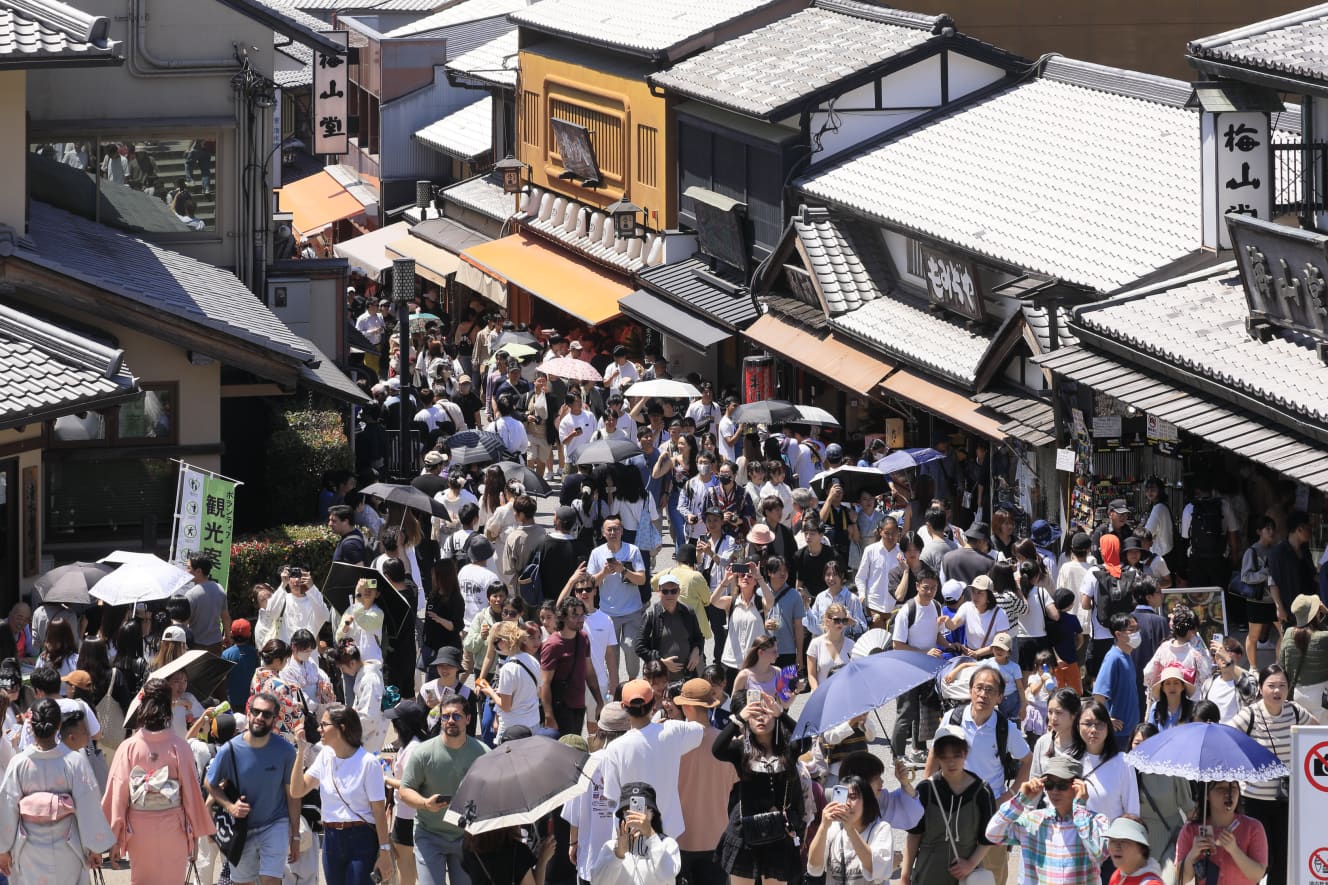Has Japan’s Economic Decline Made Dual Pricing the Norm?
Local residents, Japanese tourists, and inbound visitors find ‘triple pricing’ acceptable.
“I was watching the news and information programs during Golden Week and thought to myself that Japan has become poor. Packing cup ramen in suitcases for overseas trips, managing with them for breakfast and lunch, and dining out only in the evenings. When I saw Japanese people slurping cup ramen overseas on the news, my heart ached as I realized how much Japan, which I had longed for, had declined.”
This is spoken by Nishantha, who has lived in Japan for about 40 years and is a professor at Hagoromo International University.

While it is said that the number of overseas travelers during Golden Week has recovered to 90% of pre-COVID levels, many people have been confronted with harsh realities such as having to economize on meal expenses due to the historical weakness of the yen.
Turning attention to Japan domestically, there are establishments at various tourist spots that set prices specifically for foreign tourists, known as “inbound pricing.” A seafood bowl costing nearly 20,000 yen per bowl has sparked discussion, leading to the creation of terms like “inbound bowl.”
For inbound tourists, even a seafood bowl costing over 10,000 yen per bowl must seem like a reasonable price. However, it remains challenging for Japanese people to afford. Amidst this, there has been both support and opposition regarding the practice of setting different prices for Japanese and inbound tourists, known as “dual pricing.”
“In my home country of Sri Lanka, where tourism is a crucial source of foreign currency, dual pricing is commonplace.
Sri Lanka boasts eight UNESCO World Heritage sites, and at popular tourist destinations visited by both foreigners and locals, there are two types of entrance fees—effectively dual pricing. Citizens pay a significantly lower fee while foreigners are charged a higher rate, which can be quite substantial.
When my family visited Sri Lanka in March this year and toured several World Heritage sites, we experienced this firsthand. At Sigiriya Rock, where 80% of visitors are tourists, the entrance fee for foreigners was approximately 5,500 yen when converted to Japanese yen, while for Sri Lankan citizens it was about 60 yen. As a Japanese national who appears Sri Lankan, I paid the local rate without any checks. However, my Japanese wife was charged the foreign rate. The issue arose with our children, who were ultimately judged by appearance, resulting in us paying the foreign rate for all three.”
In Kyoto, where Nishantha currently resides, there are numerous UNESCO World Heritage sites scattered around, totaling 17 locations including 16 temples and shrines plus one castle.
For instance, admission fees are set at 500 yen for Kinkaku-ji and Ginkaku-ji, 400 yen for Kiyomizu-dera, and 600 yen for Byodo-in. None of these UNESCO World Heritage sites in Kyoto have implemented dual pricing for admission fees.
“I think it would be good to have local discounts for Kyoto residents on admission fees and entrance fees for UNESCO World Heritage sites and famous landmarks. Non-Kyoto Japanese tourists would pay the current rates, with an additional charge for inbound tourists, perhaps even implementing triple pricing. Temples could contribute the extra charges back to Kyoto City in the form of taxes or similar.
Kyoto City introduced a lodging tax in 2018. As we approach five years since its implementation, there are discussions about revising the tax rates. Currently, it’s 200 yen for stays under 20,000 yen, 500 yen for stays between 20,000 and 50,000 yen, and 1,000 yen for stays over 50,000 yen. I think it’s acceptable for Japanese nationals and foreign residents in Japan to pay 200 or 500 yen, but I feel it’s okay to charge more for inbound tourists.
Due to concerns over overtourism, Kyoto City is facing a challenging financial situation. It would be desirable for economically capable foreign tourists to contribute to Kyoto City’s financial resources by paying higher admission fees and lodging taxes compared to Japanese nationals.”
The ones prospering are hotels and restaurants owned by the Tokyo capital or foreign capital.
Kyoto City has been producing posters since 2003 with the purpose of promoting Kyoto’s charm. Their catchphrase is “It’s good that there is Kyoto in Japan.” However, Mr. Nishantha points out that “many Kyoto residents do not feel that way.”
“Certainly, Kyoto has many World Heritage sites and abundant tourism resources. However, the ones prospering from the increase in inbound tourism are mostly hotels and restaurants owned by Tokyo capital or foreign capital. If it’s Tokyo’s capital, at least the money stays within the country, but money earned by foreign companies using Kyoto’s tourism resources is taken abroad.
I don’t think many Kyoto residents feel the benefits of inbound tourism. Except for a few people profiting from business with inbound tourists.”

According to the 2024 edition of the “Travel and Tourism Competitiveness Report” released by the World Economic Forum based in Geneva, Switzerland, Japan ranked third globally. However, despite the increase in inbound tourism, only a few tourist destinations may be benefiting from its advantages.
“Not only in Kyoto, but throughout Japan, there are various tourism resources. Despite this, many regions are not effectively earning from tourism. They are failing to monetize their tourism resources. In this regard, I feel Japan is lagging behind compared to developing countries like Sri Lanka.”
Starting this summer, Yamanashi Prefecture will require climbers on the Yoshida Route of Mt. Fuji to pay a passage fee of 2,000 yen. Regarding this fee, mountaineer Ken Noguchi commented on his blog, “Even from an international perspective, 10,000 yen would still be cheap. Also, it’s common to have different entry fees for nationals and foreigners. Japanese pay 10,000 yen, foreigners pay 30,000 yen. That’s how I see it.”
“I think it’s only natural to charge a passage fee for Mt. Fuji, a valuable World Heritage site, and there should be a distinction between Japanese and foreigners. If it’s set at 2,000 yen, perhaps around 10,000 yen for foreigners might be appropriate. Foreign climbers sometimes engage in disruptive behavior or breach etiquette, which can require extra effort and manpower to manage.”
“On the other hand, how do you feel about restaurants setting higher inbound prices for foreign customers?” There seems to be divided opinions on this matter in public discourse.
“There are various approaches among businesses when it comes to serving foreign customers: some add an extra 1,000 yen due to the perceived extra effort in service, while others offer discounts to Japanese or local regulars. There are also establishments that maintain fair pricing for everyone regardless of nationality, and those that continue to adhere to a policy of not serving first-time customers. Whether to implement dual pricing or not is ultimately a decision for the business owner.
If opting for dual pricing, there needs to be a legitimate reason for setting higher prices for foreigners. When asked by foreigners why prices are higher for them compared to Japanese, the establishment should be able to explain convincingly, such as by detailing the added value in terms of food quality, service, or other aspects. This is where the skill of the business owner is tested.”
“In the ’80s and ’90s, when Japan was an economic powerhouse, Japanese people had not yet switched their way of thinking.”
Once, Japan was the world’s second-largest economic powerhouse after the United States. Nishantha first visited Japan in 1987 as a high school student. The following year, he started his life in Japan when he came to study abroad.
“I arrived in Japan during the midst of the bubble era when the Japanese economy was being praised as Japan’s number one.
It was around the time when Japanese used cars began to enter Sri Lanka. The local scenery, where elephants used to walk along the roadside, changed drastically due to the influx of Japanese used cars. I believe Japanese used cars were the tool that brought globalization to Sri Lanka. That’s why I decided to come to Japan if I were to go abroad.
Now, I keenly feel that the economy is a living entity. The current situation in Japan is completely opposite to when I arrived during its peak.”

Japan’s nominal GDP for the past year fell to fourth place globally when converted to dollars, overtaken by Germany. Per capita nominal GDP also ranked last among the G7 countries in 2022.
“In relation to dual pricing, I think we also need to consider tuition fees for foreign students. At the university where I teach, we have international students from overseas who may have chosen Japan partly because of lower tuition fees.
In Japan, various scholarships are provided to foreign students by the government and organizations, and universities that reduce tuition fees receive subsidies. As a result, the amount foreign students pay is lower.
Many of my students are in this situation; about 90% of Japanese students borrow scholarships to attend university. While international students enjoy a comfortable university life, Japanese students struggle with part-time jobs. Rather than favoring international students, I believe the Japanese government should first reconsider its economic support system for its own students.”
Japan is no longer a uniquely wealthy or vigorously thriving nation. Nishantha voices this bitter truth, suggesting that Japanese people need to recognize the reality.
“Why is there debate about dual pricing now? Perhaps because Japanese people haven’t yet shifted away from the mindset of the ’80s and ’90s, when Japan was an economic powerhouse.
In current circumstances, Japan’s position isn’t much different from that of developing countries. Objectively speaking, I believe dual pricing is natural. Starting with sectors where it’s feasible, we should implement dual pricing promptly.”
Nishantha, a professor in the Faculty of Contemporary Sociology at Hagoromo International University, is an economist and a television personality. Born in Sri Lanka in 1969, he first visited Japan at the age of 17 in 1987 as a member of the Boy Scouts. The following year, he returned to Japan for studies, attended Kyoto YMCA Nihongo Gakko, and later enrolled at Ritsumeikan University. Balancing academics and extracurricular activities, he graduated as the top student from the Faculty of Business Administration in 1994 while on a newspaper scholarship. He went on to earn a Master’s degree in Economics and a PhD in Economics (International Studies) from Ryukoku University Graduate School. In 2005, he acquired Japanese nationality. He has served as an assistant professor at Yamaguchi Prefectural University and has been in his current position since 2015. His publications include “Different Because Fun, Different Because Possible” (Iwasaki Shoten) and “Walking with Buddha in the Mystical Country Sri Lanka” (Kinobooks).
Interview and text by: Sayuri Saito